Swimming strengthens your bones through water resistance and muscle engagement, though it won’t provide the same impact benefits as weight-bearing exercises. You’ll see improved lumbar vertebral density with 3-6 hours of weekly swimming, especially if you’re postmenopausal. The water’s resistance enhances bone turnover rates while building muscle mass that supports your skeleton. Swimming also improves balance and coordination, reducing fall risk. To maximize these benefits, you’ll want to explore how combining swimming with complementary exercises creates ideal results.
The Science Behind Swimming and Bone Density
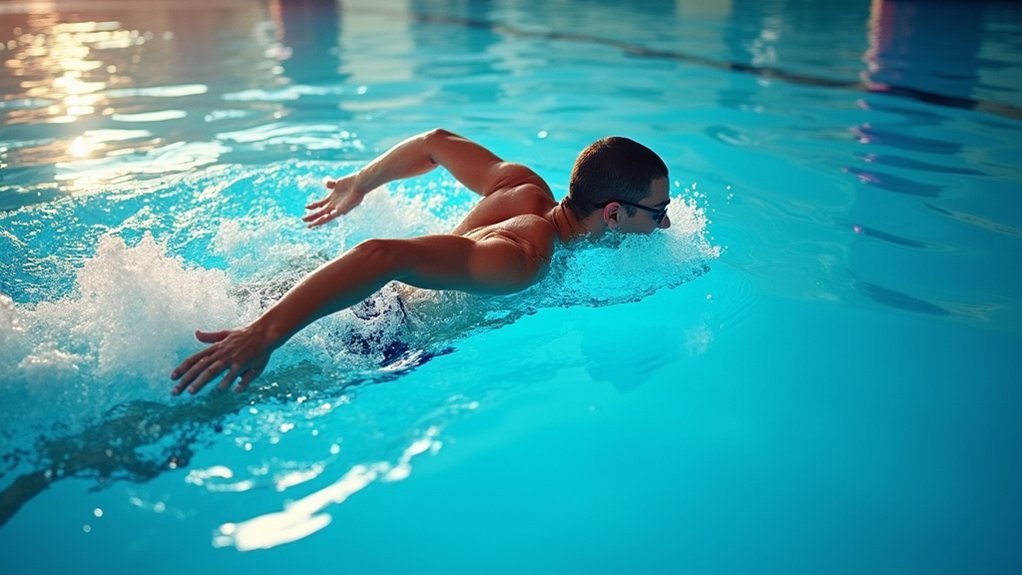
While swimming provides excellent cardiovascular benefits, it doesn’t deliver the bone-strengthening punch you might expect from your pool workouts.
Swimming functions as low-impact aerobics, which means your bones don’t experience the mechanical stress necessary for ideal growth. According to Wolff’s Law, bones need direct pressure and impact to stimulate formation and increase bone density.
Swimming’s low-impact nature means bones miss out on the mechanical stress required to trigger optimal density growth.
However, research reveals swimming isn’t entirely without merit for your skeletal system. A 2020 study showed swimmers practicing 3-6 hours weekly had notably higher lumbar vertebral density than non-swimmers.
This suggests swimming can provide some bone health benefits, particularly for postmenopausal women who may see improved mineral content.
The key takeaway: while swimming supports overall fitness and muscle strength, it can’t replace weight-bearing exercises for maximizing bone density.
How Water Resistance Affects Bone Formation
When you plunge into the pool, water resistance creates a unique mechanical environment that affects how your bones respond to exercise. This resistance engages your muscles effectively while reducing gravitational stress on your skeletal system.
Unlike weight-bearing activities that directly stimulate bone formation through mechanical loading, water’s buoyancy lessens the impact forces your bones typically experience.
However, water resistance still provides meaningful benefits for bone health. The constant pressure against your muscles during swimming movements enhances bone turnover rates, which can improve your fracture resistance over time.
Research shows swimmers maintain higher lumbar vertebral density compared to sedentary individuals. While swimming alone won’t maximize bone mineral density, it’s an excellent complement to weight-bearing exercises in your extensive fitness routine.
Swimming’s Role in Preventing Osteoporosis
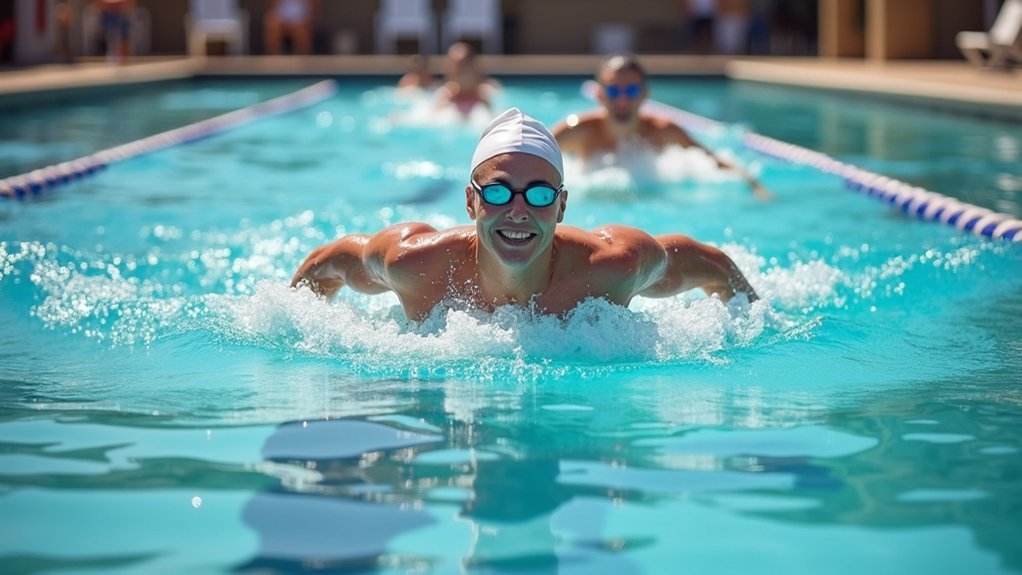
Understanding how water resistance affects bone formation sets the stage for examining swimming’s specific role in osteoporosis prevention. While swimming won’t single-handedly prevent osteoporosis, research shows it can contribute meaningfully to your bone health strategy.
A 2020 study revealed that swimmers engaging in 3-6 hours weekly had higher lumbar vertebral density than non-swimmers, particularly benefiting postmenopausal individuals. However, swimming’s limitations become apparent when considering bone mineral density (BMD) improvements.
Here’s what you should know about swimming and osteoporosis prevention:
- Swimming maintains muscle strength and coordination
- Water exercises may enhance bone turnover rates
- Swimming alone doesn’t provide ideal mechanical stress for bone formation
- Combining swimming with weight-bearing exercises maximizes osteoporosis prevention
You’ll achieve better results by pairing swimming with activities like walking or weightlifting.
Muscle Strengthening Benefits for Skeletal Support
When you swim regularly, you’re building muscle mass that directly supports your skeletal system and reduces fracture risk.
The water’s resistance engages multiple muscle groups simultaneously, creating a natural strength-training environment that promotes muscle stress against your bones.
This increased muscle strength translates into better coordination and balance, which greatly decreases your chances of falling as you age.
Swimming Builds Muscle Mass
Swimming engages every major muscle group in your body, creating an extensive strength-training workout that directly supports your skeletal system.
When you swim regularly, you’re building muscle mass that’s essential for maintaining healthy bones and preventing bone loss as you age.
Research shows swimmers who dedicate 3–6 hours weekly to swimming have considerably higher bone mineral density (BMD).
Here’s how swimming builds muscle mass for skeletal support:
- Water resistance strengthens muscles without stressing your bones, making it ideal for those with osteoporosis.
- Enhanced muscle strength improves coordination and balance, reducing fall risks.
- Increased muscle mass stimulates bone growth through beneficial mechanical stress.
- Full-body engagement targets multiple muscle groups simultaneously for thorough strengthening.
Your muscles become stronger while protecting your skeletal health.
Enhanced Coordination and Balance
Beyond building raw muscle strength, the coordinated movements required in swimming greatly enhance your balance and proprioception—your body’s ability to sense its position in space.
When you’re swimming, water’s resistance forces your muscles to work together, creating enhanced coordination that translates to better stability on land. This improved body awareness markedly reduces your fall risk, which is essential for protecting bones from fractures.
Swimming’s muscle-strengthening effects also promote better posture by supporting proper spinal alignment.
You’ll notice less stress on your joints and reduced strain on your skeletal system as your strengthened muscles provide better structural support.
Since swimming allows you to build this coordination safely without high injury risk, it’s an ideal exercise for maintaining overall health while specifically protecting your bone integrity.
Balance and Coordination Improvements Through Swimming
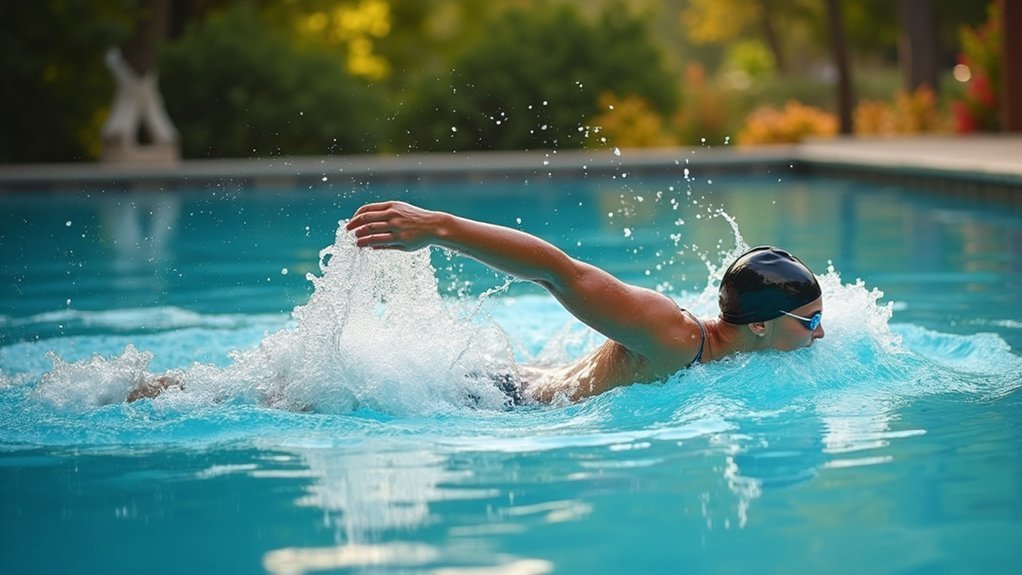
As you move through water during swimming sessions, your body naturally develops enhanced balance and coordination by engaging multiple muscle groups simultaneously.
This improvement directly supports your bone strength through better stability and reduced fall risk.
Swimming’s unique benefits for balance include:
Water resistance forces continuous stabilization while swimming, naturally enhancing your proprioception, core strength, and coordination for better balance.
- Enhanced proprioception – You’ll develop better spatial awareness, helping your body sense its position and reducing injury risk, especially as you age.
- Strengthened core muscles – Water resistance forces you to stabilize continuously, building the foundational strength that supports proper balance.
- Improved fine motor skills – Repetitive stroke patterns refine your coordination, making daily activities safer and more controlled.
- Cross-training benefits – Your enhanced balance translates to better performance in other bone-strengthening activities.
Combining Swimming With Weight-Bearing Activities
You’ll maximize your bone health by pairing swimming with specific weight-bearing exercises that create the mechanical stress your bones need to stay strong.
Your weekly routine should strategically combine swimming sessions with activities like jogging, resistance training, and squats to target different bone groups effectively.
This combination approach can greatly boost your bone mineral density, especially if you’re at higher risk for osteoporosis.
Best Weight-Bearing Exercises
While swimming offers excellent cardiovascular benefits and some bone-strengthening effects, combining it with targeted weight-bearing exercises creates the ideal approach for maximizing bone mineral density.
You’ll want to incorporate activities that create mechanical stress on your bones, stimulating tissue production that swimming alone can’t provide.
Here are the most effective weight-bearing exercises to complement your swimming routine:
- Jogging or brisk walking – These activities apply direct stress to your spine and leg bones.
- Weightlifting with squats and deadlifts – Targets major bone groups while building muscle strength.
- Resistance training with hamstring curls – Strengthens posterior leg muscles and improves balance.
- Stair climbing or step-ups – Provides impact loading for hip and spine bone mineral density (BMD).
Weekly Exercise Schedule
Creating a structured weekly schedule that balances swimming with weight-bearing activities maximizes your bone health benefits while maintaining the cardiovascular advantages you love about pool workouts.
Dedicate 3-6 hours weekly to swimming as part of your 150 minutes of moderate-intensity aerobic exercise. Complement this with weight-bearing exercises like walking, jogging, or strength training 2-3 times per week to stimulate bone mineral density (BMD).
Add 5 minutes daily of high-impact activities such as jumping rope or stair climbing to further promote bone formation. Include flexibility exercises like yoga or tai chi twice weekly for balance and stability.
This combination approach guarantees you’re addressing swimming’s non-weight-bearing limitation while supporting ideal BMD through targeted weight-bearing exercises that strengthen your skeletal system.
Bone Density Benefits
Although swimming provides excellent cardiovascular benefits, its non-weight-bearing nature means you’ll need to pair it with targeted activities to maximize bone density gains.
Research shows swimmers who log 3-6 hours weekly demonstrate considerably higher bone mineral density than non-swimmers, especially in lumbar vertebrae.
However, you’ll achieve best results by combining this aerobic exercise with weight-bearing activities.
To enhance your bone health effectively:
- Add resistance training – Include weightlifting sessions 2-3 times weekly
- Incorporate high-impact exercises – Try jogging or jumping activities
- Maintain adequate nutrition – Guarantee sufficient calcium and vitamin D intake
- Create balanced routines – Alternate swimming days with weight-bearing workouts
This combination approach stimulates bone formation more effectively than swimming alone, helping you build stronger bones and reduce osteoporosis risks.
Essential Nutrients to Maximize Swimming’s Bone Benefits
Since swimming alone doesn’t provide the bone-loading forces that activities like running or weightlifting offer, you’ll need to fuel your body with specific nutrients that enhance bone-building potential.
Adults require 1,000 mg of calcium daily, with women over 51 needing 1,200 mg from dairy, leafy greens, and fortified foods. Vitamin D enhances calcium absorption—you need 600 IU until age 70, then 800 IU from sunlight, fatty fish, or supplements.
Boost your bone health further by consuming polyphenols from dried plums, which improve calcium absorption.
Support your gut health with fiber-rich foods like beans, onions, kale, and whole grains, as a healthy digestive system promotes ideal calcium uptake for stronger bones.
Age-Related Considerations for Swimmers
As you age, your bones face a unique challenge when swimming serves as your primary form of exercise.
While swimming offers excellent cardiovascular benefits, it doesn’t provide the mechanical stress needed to stimulate bone formation, potentially leading to decreased bone density over time.
Consider these age-related factors:
- Peak bone density occurs around age 30, making bone preservation vital as you get older.
- Postmenopausal women may see improved bone mineral content from swimming but not necessarily increased density.
- Joint-friendly benefits make swimming ideal for those with arthritis or mobility issues.
- Supplemental weight-bearing exercises become essential to counteract age-related bone loss.
You’ll need to incorporate high-impact activities alongside your swimming routine to maintain ideal bone health throughout your golden years.
Swimming Safety Guidelines for Fragile Bones
When you have osteoporosis or low bone density, swimming becomes one of your safest exercise options. The buoyant water environment reduces fall risks and fracture potential while providing excellent cardiovascular benefits.
Swimming offers a protective, buoyant environment that minimizes fracture risks while delivering essential cardiovascular benefits for osteoporosis patients.
However, you’ll need to follow specific safety guidelines to maximize benefits while protecting your fragile bones. Focus on gentle swimming strokes and water-based exercises that don’t involve twisting or sudden movements.
You should include mid-impact weight-bearing exercises alongside your swimming routine to stimulate bone strength effectively. This combination helps enhance bone mineral density, especially if you’re postmenopausal.
There are exercises to avoid entirely, including high-impact activities and movements that stress your spine. Consult your healthcare provider before starting any swimming program to develop a personalized plan that addresses your specific bone health needs.
Long-Term Bone Health Outcomes From Regular Swimming
Although swimming doesn’t provide the direct bone-loading benefits of weight-bearing exercises, research reveals promising long-term outcomes for your bone health when you maintain a regular swimming routine.
Studies show swimmers who engage in 3-6 hours weekly demonstrate considerably higher bone mineral density, especially postmenopausal individuals. Your vertebral bone density can improve compared to non-swimmers through consistent aquatic exercise.
Here’s what regular swimming contributes to your long-term bone health:
- Enhanced muscle strength – Strengthens supporting muscles around your bones
- Improved coordination – Reduces fall risk that could lead to fractures
- Increased bone turnover rates – Potentially enhances fracture resistance over time
- Better overall bone maintenance – Supports bone health through indirect mechanisms
You’ll achieve ideal results by combining swimming with weight-bearing activities for thorough bone protection.
Frequently Asked Questions
Can Swimming Strengthen Your Bones?
Swimming can’t greatly strengthen your bones since it’s non-weight-bearing exercise. You’ll need to combine swimming with weight-bearing activities like walking or weightlifting to effectively stimulate bone formation and improve density.
What Activity Is Best for Bone Density?
You’ll get the best bone density benefits from weight-bearing exercises like walking, jogging, and weightlifting. High-impact activities such as jumping and dancing are particularly effective since they create mechanical stress that stimulates bone growth.
Is Swimming Good for Your Joints?
Yes, swimming’s excellent for your joints. Water’s buoyancy reduces stress while you’re exercising, improving mobility and flexibility. You’ll strengthen supporting muscles without high-impact strain, making it perfect if you’ve got arthritis or joint pain.
What Sport Increases Bone Density?
You’ll increase bone density most effectively through weight-bearing sports like running, weightlifting, and jumping rope. These high-impact activities create bone tension that stimulates tissue production, strengthening your legs, hips, and spine.
In Summary
You’ve now discovered how swimming transforms your bone health through water resistance, muscle strengthening, and improved balance. Don’t forget to fuel your body with calcium and vitamin D to maximize these benefits. Whether you’re young or managing age-related bone concerns, swimming offers a safe, low-impact solution for long-term skeletal wellness. Start incorporating regular swimming sessions into your routine, and you’ll build stronger bones while protecting yourself from osteoporosis and fractures.


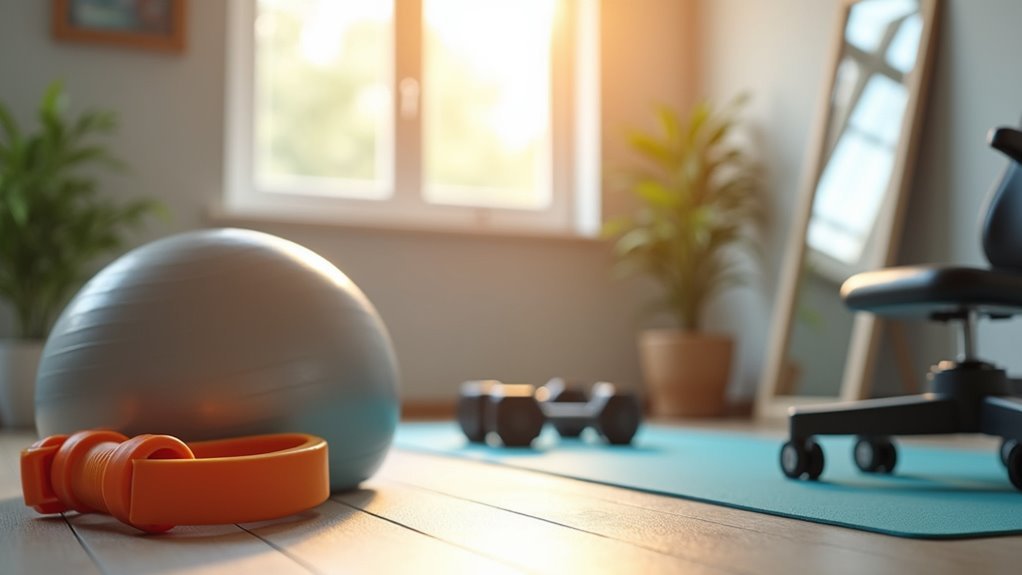
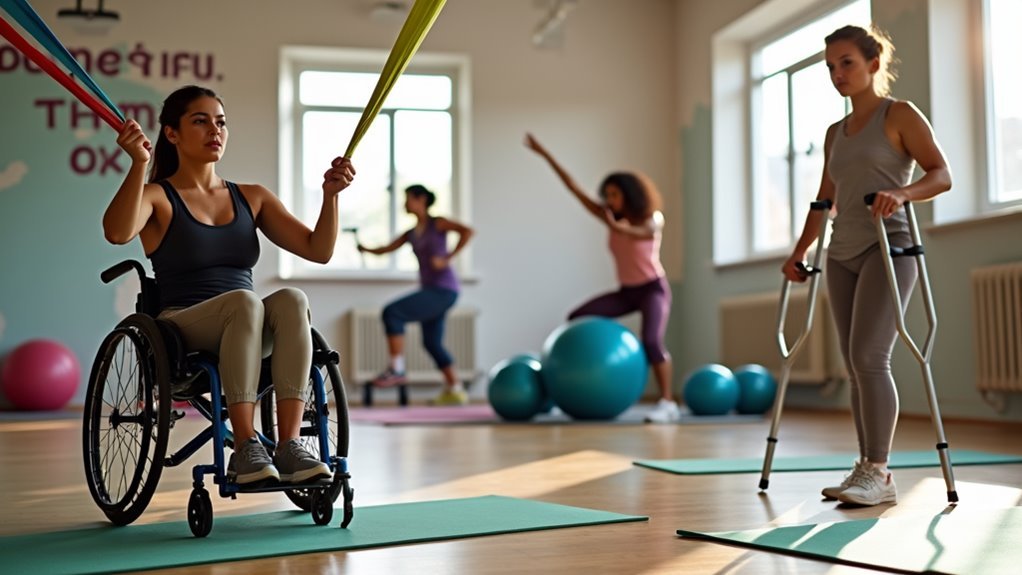
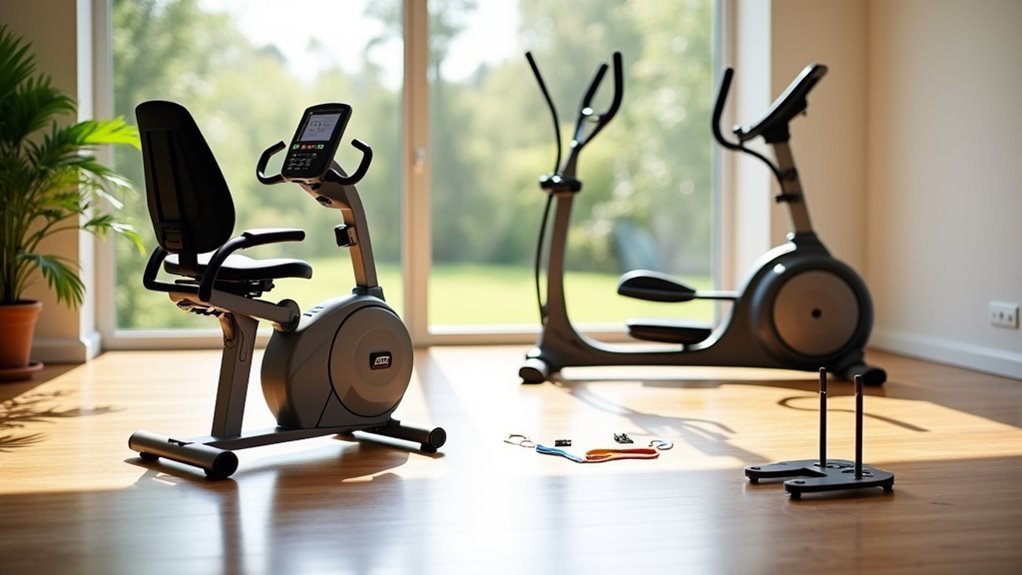
Leave a Reply